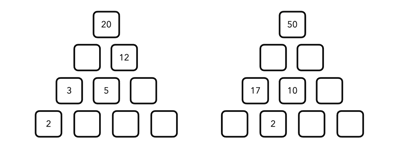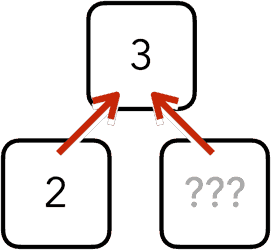Here’s a pair of worksheets a teacher sent in.

While they certainly look more interesting than a bunch of practice problems, we have to go beyond the surface level and ask, “How are we asking students to think.” Where are we on Bloom’s Taxonomy?
Each box in the pyramid is the sum of the two boxes below it. For example, 3 is the sum of 2 and a “mystery number.”

Hopefully you can already see the problem. 😝
This Is Low Level!
This is just a new way of asking “2 plus what equals 3?” This is low-level thinking. We’re recalling basic addition facts.
The teacher who sent these in noticed that his students enjoyed the puzzles at first, but quickly tired of them. “What’s wrong?” he wondered. Aren’t puzzles supposed to be fun?
So, I worked through a couple of the puzzles.

I felt exactly like the students. Initially, it was interesting. And then, once I figured it out, the worksheets became pretty boring. Because, at the end of the day, it’s just practice problems masquerading as something more interesting.
Gotta Taste That Soup!
At a restaurant, a chef would never serve soup that they hadn’t first tasted. You have to know what you’re sending out to customers!
But, as a teacher, I’d frequently give out worksheets, projects, and puzzles that I had never worked through myself. This pyramid puzzle is one example of what can happen. Oops! I accidentally gave my most advanced students more low-level practice problems!
So? What To Do?
Honestly, I’d just dump this whole idea.
If I have students who have demonstrated that they can solve 2 + x = 3, then I’d move them on to the next thing. Accelerating is the cheapest and easiest way to differentiate.
But, if for some reason I have to keep students on this particular topic, I would reach for something like the examples at Open Middle.
Use the digits 0-9, at most once, to complete the equation.
- What is the greatest result you can make?
- What is the least result you can make?

A sample solution is: 10 + 4 = 23 – 9, which gives us 14 = 14. Can students find a value larger than 14? Smaller?
This one problem will keep students thinking for much longer than those low-level pyramid puzzles!
Related Videos For Byrdseed.TV Members



